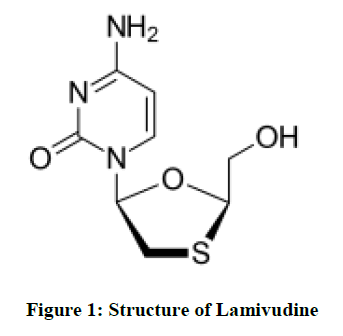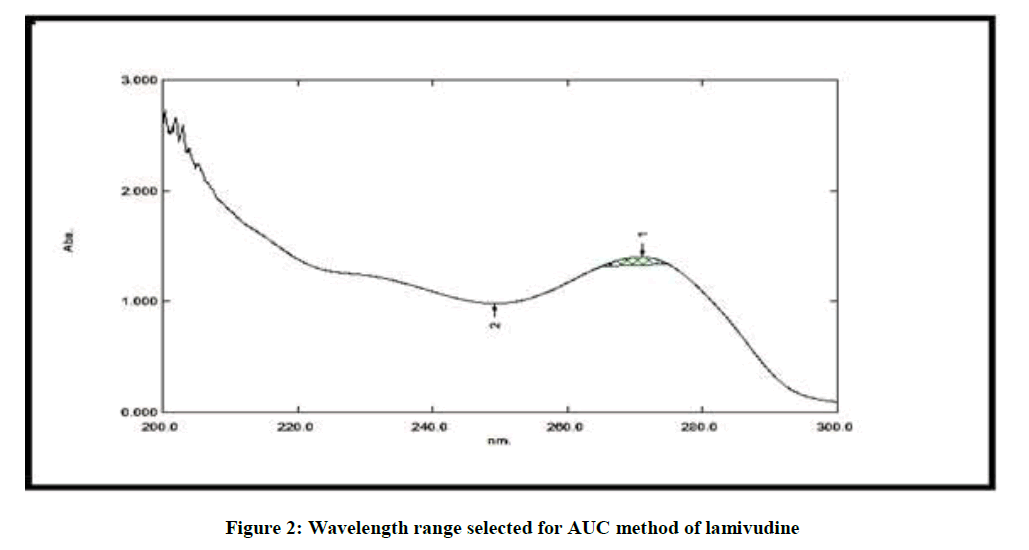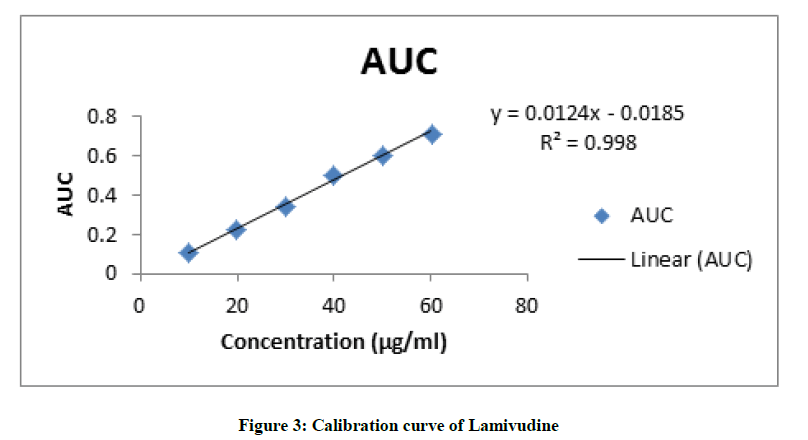Research Article - Der Pharma Chemica ( 2018) Volume 10, Issue 5
Development and Validation of UV Spectrophotometric Method for Estimation of Lamivudine in Bulk and Tablet Dosage Form
M Akif Haque*, Kuchukuntla Mounika and Vasudha Bakshi
Department of Pharmaceutics, Anurag Group of Institution (formally) Lalitha College of Pharmacy, Venkatapur, Hyderabad, India
- *Corresponding Author:
- M Akif Haque
Department of Pharmaceutics
Anurag Group of Institution (formally) Lalitha College of Pharmacy
Venkatapur, Hyderabad, India
Abstract
UV Spectrophotometric method has been developed for estimation of lamivudine in bulk and tablet dosage form by using water as solvent. Method developed is Area Under Curve (AUC) method. For analysis of lamivudine by AUC method the wavelength range selected was 265 nm to 275 nm because the linearity was obtained within this area with good reproducibility of results. Lamivudine shows absorbance maxima (λmax) at 271 nm scanned in UV range of 400 nm to 200 nm. Lamivudine obeys Beer’s law in the concentration range of 10-60 μg/ml.
Keywords
Lamivudine, Area under curve method (AUC), ICH guidelines
Introduction
Lamivudine (Figure 1), commonly called 3TC, is an antiretroviral medication used to prevent and treat HIV/AIDS. It is also used to treat chronic hepatitis B when others options are not possible.
Lamivudine is a nucleotide reverse transcriptase inhibitor and works by blocking the HIV reverse transcriptase and hepatitis B virus polymerase. It is effective against both HIV-1 and HIV-2. Lamivudine was approved for used in United States in 1995. The aim of this work is to develop and validate an analytical method by using UV- Visible spectro-photometry for the estimation of lamivudine in bulk and pharmaceutical dosage forms. Lamivudine is chemically 4-Amino-1-[2R,5S]-2-(hydroxymethyl)-1,3-oxathiolan-5-yl]-1,2-dihydropyrimidin-2- one [1].
Materials and Methods
The pure API sample of lamivudine was obtained as a free gift sample while distilled water were used as solvent. The marketed combined pharmaceutical dosage form of lamivudine (lamivir-150 mg) was purchased from local market.
Instrumentation
The instrument used for the study was an UV double beam spectrophotometer (Model UV-1800, Shimadzu UV- Visible Spectro - photometer) with 1 cm matched pair quartz cells [2].
Preparation of standard stock solution and calibration curve
Accurately about 10 mg lamivudine was weighed and transferred to 100 ml volumetric flask. To it water was added to dissolve the drug completely with vigorous shaking. Then the volume was made up with the same solvent up to the mark to give the standard stock solution of concentration 100 μg/ml. Working standard solution of 100 ug/ml were scanned in the entire UV range of 400-200 nm to determine the λmax. The λmax of lamivudine was 271 nm.
From above standard stock solution of (100 μg/ml), pippete out aliquots 1 ml, 2 ml, 3 ml, 4 ml, 5 ml, 6 ml in 10 ml volumetric flask. The volume was made up with distilled water to form solutions of 10 to 60 μg/ml of lamivudine [3]. The area under the curve of these solutions was measured between 265 nm to 275 nm against reagent blank in spectrum mode. A calibration curve of area and concentration was plotted to obtain linearity and regression equation.
Area Under the Curve (AUC) method
The AUC (area under curve) method involves the calculation of integrated value of absorbance with respect to the wavelength between two selected wavelength 265 nm and 275 nm. Dilution of the standard stock solutions, working standard solutions of suitable concentrations were prepared accurately to determine the range for analysis (area under the curve). The standard solutions were then scanned in the spectrum mode of the instrument from 400 nm to 200 nm. The absorbance maxima of these solutions were found with a sharp peak at wavelength 271 nm. The area under the curve between 265 nm to 275 nm was selected (Figure 2) for the calculation [4].
The concentration range was found to be 10 to 60 μg/ml for lamivudine. The regression equation for lamivudine was found to be 0.0124 x - 0.0185 and (r2) was found to be 0.998. Using the regression equation, the unknown concentrations of the drug were determined in bulk and formulations.
Analysis of tablet formulation
Twenty tablets of marketed formulation were accurately weighed and powdered. A quantity of powder equivalent to 10 mg lamivudine was transferred to 100 ml volumetric flask and dissolved in water and final volume was made up to the mark of concentration 100 ug/ml. From the above stock solution 1 ml, 2 ml, 3 ml, 4 ml, 5 ml, 6 ml of solution was transferred in 10 ml volumetric flask and was diluted with water up to 10 ml which produces concentration of 10 to 60 ug/ml concentration of lamivudine. The solutions were scanned under UV region (400 nm to 200 nm) and area of spectrum was between the wavelength range 265 nm to 275 nm [5]. Analysis procedure was repeated three times with tablet formulation. The results of tablet analysis are reported in table.
Validation of developed method
Linearity
Appropriate dilutions of standard stock solutions were assayed. For the developed method the concentration range was found to be 10 to 60 ug/ml for lamivudine. The linearity data of the method are presented in Figure 3, Tables 1 and 2.
| Sr. No | Concentration (µg/ml) | AUC |
|---|---|---|
| 1 | 10 | 0.108 |
| 2 | 20 | 0.221 |
| 3 | 30 | 0.346 |
| 4 | 40 | 0.495 |
| 5 | 50 | 0.602 |
| 6 | 60 | 0.716 |
Table 1: Standard calibration table for lamivudine in AUC method
| Title | Mean | SD | SEM |
|---|---|---|---|
| Slope | 0.0124 | 0.000316 | 0.001467 |
| Y-intercept | 0.018 | 0.01703 | 0.01577 |
| R2 Value | 0.998 | 0.003457 | 0.001188 |
Table 2: Statistical validation of calibration curve of Lamivudine by AUC method
Precision
Repeatability
To check the degree of repeatability of these methods, suitable statistical evaluation was carried out. Repeatability was performed for three times with tablet formulation. The standard deviation, coefficient of variation and standard error was calculated. The results of statistical evaluation are given in Table 3.
| S. No. | Tablet sample name | Amount present (mg/tab) | Amount taken (mg) | Amount found (mg/tab) | Percentage of label claim |
|---|---|---|---|---|---|
| 1 | 150 | 10 | 9.792 | 97.92 | |
| 2 | Lamivudine | 150 | 10 | 9.764 | 97.64 |
| 3 | 150 | 10 | 9.849 | 98.49 |
Table 3: Analysis of tablet formulation
Accuracy
The accuracy was checked for the developed method, recovery studies were carried out at 80, 100 and 120 % of the test concentration. The recovery study was performed three times at each level. The results of the recovery studies are shown in Tables 4 and 5.
| S. No. | Tablet Sample Name | % Mean | SD | COV | SE |
|---|---|---|---|---|---|
| 1 | Lamivudine | 98.01 | 0.1876 | 0.21 | 0.1002 |
Table 4: Statistical evaluation by AUC method
| Tablet sample name | Level of recovery (%) | Amount present (mg/tab) | Amount taken (mg) | Amount of standard added (mg) | Total amount recovered (mg) | % Recovery |
|---|---|---|---|---|---|---|
| Lamivudine | 80 | 150 | 10 | 8 | 18.43 | 100.01 |
| 150 | 10 | 8 | 17.98 | 99.84 | ||
| 150 | 10 | 8 | 18.09 | 99.92 | ||
| 100 | 150 | 10 | 10 | 19.46 | 99.49 | |
| 150 | 10 | 10 | 20.05 | 100.05 | ||
| 150 | 10 | 10 | 19.89 | 99.88 | ||
| 120 | 150 | 10 | 12 | 21.06 | 100.49 | |
| 150 | 10 | 12 | 20.98 | 99.9 | ||
| 150 | 10 | 12 | 21.43 | 100.58 |
Table 5: Recovery studies
To perform recovery studies at 80% of the test concentration, 10 mg of lamivudine was weighed and 8 mg of standard lamivudine was added, the mixture was mixed thoroughly. From this sample equivalent to 10 mg of lamivudine was weighed and transferred to a 100 ml volumetric flask. To it water was added to dissolve the sample. Finally the volume was made up to the mark with water. The solution was filtered through wattman filter paper. The sample mixture was analyzed. Similarly recovery studies at 100% and 120% of the test concentration were performed. The recovery study was performed three times at each level for the tablet formulations. The results of the recovery studies along with its statistical validation are given in the Tables 4-6. The LOD and LOQ of lamivudine were determined.
| S. No. | Tablet sample name | Level of recovery (%) | (%) Mean | SD | COV | SE |
|---|---|---|---|---|---|---|
| 1 | 80 | 99.92 | 0.5357 | 0.375 | 0.0248 | |
| 2 | Lamivudine | 100 | 99.94 | 0.274 | 0.2705 | 0.1142 |
| 3 | 120 | 100.03 | 0.2652 | 0.2572 | 0.1482 |
Table 6: Statistical validation of recovery studies
Results and Discussion
Linearity range of lamivudine was 10 to 60 ug/ml at calculated area between wavelength range from 265 nm to 275 nm. The coefficient of correlation for lamivudine at calculated area is 0.9981. Percentage estimation lamivudine from tablet dosage form is 98.01 with standard deviation ≤ 2 (Tables 3 and 6). Precision is determined by studying the repeatability. The standard deviation, coefficient of variance and standard error is calculated for lamivudine. The validity and reliability of proposed methods is assessed by recovery studies (Tables 4 and 5).
The LOD value is 0.1010 ug/ml while LOQ value is 0.3501 ug/ml in proposed method for lamivudine. Low values of LOD and LOQ indicates good sensitivity of proposed methods [6].
The % mean, standard deviation (SD), coefficient of variation (COV) and standard error (SE) calculated are low, indicating high degree of precision of the method [7].
Conclusion
The developed method was sensitive, unique, fast and reproducible for estimation of lamivudine in bulk mix and pharmaceutical dosage form. It is conclude that this method is novel for drug estimation.
References
- S. Shalini, Dig. J. Nanomater. Biol. Struct., 2009, 4, 357-360.
- Indian Pharmacopoeia, Government of India: Controller of Publications, Government of India Ministry of Health & Family Welfare, 2, 1276.
- M.V. Baig, Asian. J. Chem., 2001, 13, 185-189.
- S. Appalaraju, A.B. Karadi, G.S. Kamalapurkar, P.S. Sarasambi, Asian. J. Chem., 2002, 14, 475-478.
- ICH, Q2 (R1) validation of analytical procedures: text and methodology, International conference on Harmonization, 1996.
- ICH, Q1A (R2) stability testing of new drug substances and products, International conference on Harmonization, 1996.
- http://ipc.nic.in/show mono prepared details






